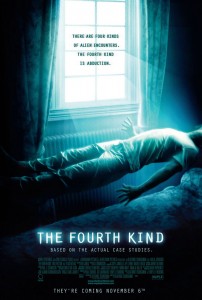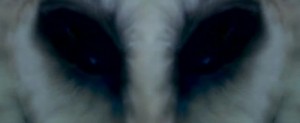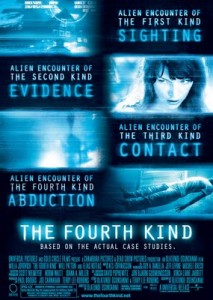 TheoFantastique is pleased to present its first guest posting, a review of The Fourth Kind by Paul Meehan, author of several books including Tech-Noir: The Fusion of Science Fiction and Film Noir (McFarland, 2008), Cinema of the Psychic Realm: A Critical Survey (McFarland, 2009), and Saucer Movies: A UFOlogical History of the Cinema (The Scarecrow Press, 1998).
TheoFantastique is pleased to present its first guest posting, a review of The Fourth Kind by Paul Meehan, author of several books including Tech-Noir: The Fusion of Science Fiction and Film Noir (McFarland, 2008), Cinema of the Psychic Realm: A Critical Survey (McFarland, 2009), and Saucer Movies: A UFOlogical History of the Cinema (The Scarecrow Press, 1998).
SLEEPING WITH THE ALIENS
WEIRD ENCOUNTERS OF THE FOURTH KIND
by Paul Meehan
The enigma of alien abduction is one of the enduring mysteries of our time. Beginning with the famous case of Betty and Barney Hill in 1961, in which a couple were allegedly abducted while driving down a New Hampshire highway late one night, these reports of extraterrestrial kidnappings have continued unabated into the 21st Century. While a minority of abductees claim that the experience is a positive one, most of those who have purportedly been taken relate terrifying stories about being subjected to strange medical experiments and mysterious mind games.
Alien abductions reached the zenith of their popularity in 1987 with the publication of horror writer Whitley Strieber’s book Communion and UFO researcher Budd Hopkin’s Intruders, which were serious explorations of the phenomenon that made the New York Times bestseller list. Because abduction reports were so similar to each other and presented a very limited narrative format (people are picked up, prodded and let go), the experience has not translated well onto the screen. Only two theatrically-released features were based on real-life cases, the film version of Strieber’s Communion (1989) and the abduction account of Arizona logger Travis Walton, Fire in the Sky (1993). Two telefilms, NBC-TV’s The UFO Incident (1975), a faithful rendition of the Hill abduction case starring James Earl Jones and Estelle Parsons and CBS’s Intruders, based on the Hopkins book, were the two most powerful screen treatments of the abduction theme.
Now comes writer/director Olatunde Osunsanmi’s The Fourth Kind (2009) with a tale of alien abduction allegedly based on 65 hours of “archival footage” of “actual case histories” relating to a series of purported abductions in the Nome, Alaska area in October of 2000. The film’s title is a reference to the typology of UFO sightings formulated by the legendary ufologist Dr. J. Allen Hynek that was used for the title of Steven Spielberg’s UFO opus Close Encounters of the Third Kind, with abduction being the fourth level of an ET encounter. Resident Evil star Milla Jovovoch plays Alaskan psychiatrist Abigail Tyler, who is mourning her husband Will after he was knifed to death by an unknown assailant in their home and is caring for her two children. Abigail is counseling Nome residents with sleep disorders who all tell the same story of waking up in the middle of the night and seeing a scary-looking owl staring at them and hearing voices speaking in a strange language. When one of her patients, Tommy (Corey Johnson), goes nutzoid after a hypnosis session and kills his family and himself, Nome Sheriff August (Will Patton) suspects that Abigail’s therapy was somehow responsible for the tragedy. Abigail and her psychiatrist colleague, Dr. Abel (Elias Koteas) fire back by citing dozens of mysterious deaths and disappearances that have occurred in the Nome area since the 1960s. “There’s something going on in this town that we don’t understand,” she warns the Sheriff.
 Things continue to go bump in the night as Abby finds a weird-looking mark on her body and suspects that she herself may have been abducted and that aliens may have been responsible for her husband’s death. An expert in ancient Near Eastern tongues identifies the language on the police tapes of Tommy’s murder/suicide as ancient Sumerian, the first written language in history dating back to the Fourth Millennium B.C.E. The mysterious voice seems to be saying, “Our creation…examine, ruin and destroy,” in the ancient language Then another patient, Scott (Enzo Cilenti) insists on being hypnotized in the wake of an abduction experience he describes as “the worst you could ever imagine,” and is possessed by an alien force during the session that causes him to levitate and go into convulsions that literally break his back. A chagrined Sheriff August orders Abby confined to house arrest after this debacle, but a UFO descends on her house in the middle of the night to abduct Abby’s young daughter, Ashley (Mia McKenna Bruce). Despite the fact that a police officer witnessed the UFO while the police video recorder conveniently goes blank, August still blames Abby for her daughter’s disappearance. In the movie’s climax, Dr. Elias hypnotizes Abigail in an attempt to probe her own abduction memories and ultimately solve the riddles of her husband’s murder and her daughter’s disappearance.
Things continue to go bump in the night as Abby finds a weird-looking mark on her body and suspects that she herself may have been abducted and that aliens may have been responsible for her husband’s death. An expert in ancient Near Eastern tongues identifies the language on the police tapes of Tommy’s murder/suicide as ancient Sumerian, the first written language in history dating back to the Fourth Millennium B.C.E. The mysterious voice seems to be saying, “Our creation…examine, ruin and destroy,” in the ancient language Then another patient, Scott (Enzo Cilenti) insists on being hypnotized in the wake of an abduction experience he describes as “the worst you could ever imagine,” and is possessed by an alien force during the session that causes him to levitate and go into convulsions that literally break his back. A chagrined Sheriff August orders Abby confined to house arrest after this debacle, but a UFO descends on her house in the middle of the night to abduct Abby’s young daughter, Ashley (Mia McKenna Bruce). Despite the fact that a police officer witnessed the UFO while the police video recorder conveniently goes blank, August still blames Abby for her daughter’s disappearance. In the movie’s climax, Dr. Elias hypnotizes Abigail in an attempt to probe her own abduction memories and ultimately solve the riddles of her husband’s murder and her daughter’s disappearance.
Writer/director Osunsanmi presents this narrative using split screens that reportedly show the “real” Abigail Tyler (as portrayed by an uncredited actress) and her patients on “documentary” videos on one half of the screen going through the identical actions that are dramatized by Jovovich and the actors on the other half. Osunsanmi even becomes an actor in his own movie when he appears as Abigail’s interviewer in a tape purportedly made at Chapman University, a real college in Orange, California. In an effort to take The Fourth Kind “back over the line from fiction to reality,” (in the film’s own words), the movie attempts to pass off bogus video archival footage of therapy sessions and police videotapes as real documents. In addition, the release of The Fourth Kind was accompanied by a clever ad campaign designed to mislead audiences into believing that the events depicted are factual, even going so far as to set up a phony website about Dr. Abigail Tyler’s Alaskan medical practice and manufactured Internet stories about her. A September 1, 2009 investigative piece written by Kyle Hopkins for the Anchorage Daily News convincingly debunks the existence of Dr. Tyler and the events depicted in the film. As for the mysterious deaths and disappearances, of which there have been about 20 since the 1960s, an FBI investigation conducted in 2005 concluded that most of the deaths were related to alcoholism and exposure to the elements in Nome’s harsh environment, with no hint of alien involvement.
 In cinematic terms, The Fourth Kind does establish considerable screen tension and uses the Blair Witch-inspired technique of filming people who are acting intensely frightened in order to induce similar feelings in the audience. Osunsamni’s style is documentarian, utilizing shaky hand-held camera setups, naturalistic lighting, time-coded video and split screen cinematography. The photogenic Milla Jovovich carries much of the film with her earnest portrayal of the tormented Abigail, but she is sometimes upstaged by the intense performance of the odd-looking unknown actress playing the “real” Dr. Tyler, who often appears onscreen in the same split frame. Professional thesps Will Patton and Elias Koteas lend their support, but none of the supporting characters is drawn in any depth. The film seems to take its cue from The Mothman Prophecies (2002), both in its subject matter of mysterioso goings-on in a backwater stretch of rural America and in its coy avoidance of showing anything overtly extraterrestrial. Much of The Fourth Kind was shot in Bulgaria, lending its “Alaskan” locations a temperate, forested look in lieu Nome’s real landscape of frozen Arctic tundra.
In cinematic terms, The Fourth Kind does establish considerable screen tension and uses the Blair Witch-inspired technique of filming people who are acting intensely frightened in order to induce similar feelings in the audience. Osunsamni’s style is documentarian, utilizing shaky hand-held camera setups, naturalistic lighting, time-coded video and split screen cinematography. The photogenic Milla Jovovich carries much of the film with her earnest portrayal of the tormented Abigail, but she is sometimes upstaged by the intense performance of the odd-looking unknown actress playing the “real” Dr. Tyler, who often appears onscreen in the same split frame. Professional thesps Will Patton and Elias Koteas lend their support, but none of the supporting characters is drawn in any depth. The film seems to take its cue from The Mothman Prophecies (2002), both in its subject matter of mysterioso goings-on in a backwater stretch of rural America and in its coy avoidance of showing anything overtly extraterrestrial. Much of The Fourth Kind was shot in Bulgaria, lending its “Alaskan” locations a temperate, forested look in lieu Nome’s real landscape of frozen Arctic tundra.
While purporting to be a true-life archival record of the abduction phenomenon, The Fourth Kind offers up a smorgasbord of ufological cliches and half-truths. To set the record straight, no abductee has ever murdered anyone as a result of their experiences, nor has anybody ever levitated or suffered back-breaking injury during a hypnotic recall session. Contrary to popular belief, alien abductions are not connected in any way we know of with missing persons cases, murders or unexplained deaths. According to research carried out by legitimate abduction investigators like Budd Hopkins, Raymond Fowler and David Jacobs, abductions are ongoing, intergenerational studies that would be severely impeded by its human subjects dying, and although abductees report painful and terrifying experiences, no one has been seriously harmed during abductions. The Sumerian language angle is derived from the work of rogue archaeologist Zecharia Sitchin, a theme which has been amplified in recent novels by Whitley Strieber but does not appear in mainstream abduction research. On the other hand, the film’s owl imagery has frequently been reported as what is termed a “screen memory” of gray aliens used to mask their true appearance, but whether this is a function of the human mind or an illusion produced by the aliens is open to debate.
Despite its many flaws and execrable advertising campaign, The Fourth Kind does manage to capture the mind-numbing terror of the abduction phenomenon, as anyone who has listened to the hypnotic regression tapes of Betty and Barney Hill can attest. But it’s also possible that the director is describing an entirely different phenomenon, that of sleep paralysis. This is an experience that occurs in a twilight state between sleep and wakefulness in which one seems to awaken paralyzed in bed. Some kind of being or entity is perceived to enter the room and approach the bed. The “entity” then begins to exert pressure on the sleeper’s chest until they awaken, only to find themselves alone in the room. Sometimes anomalous lights can be perceived, and sexual arousal can be a feature of the experience. Sleep paralysis is frequently found in people who suffer from bouts of sleepwalking, or somnambulism, and is also related to hypnopompic and hypnogogic sleep hallucinations. Alaska, where there are months on end of darkness or sunlight, is a prime location for sleep disorders (think of Al Pacino trying to get some shuteye in the Land of the Midnight Sun in the 2002 crime thriller Insomnia).
It’s easy to see how episodes of sleep paralysis, which is reported in many cultures around the world, could be interpreted as a close encounter with a ghost, a vampire, an incubus—or an alien. Indeed, all alleged alien abductions that begin in a sleep state are suspect. The abduction experiences described in The Fourth Kind all occur during sleep, and I suspect that director Osunsanmi has had a personal experience of sleep paralysis that provided the inspiration for this film. In other words, he may have been “sleeping with the aliens.”





I can’t tell you how glad I am to see sleep paralysis being talked about here at Theofantastique. As somebody who suffered for years from shattering episodes of this disorder, complete with the hypnagogic visions of a malevolent presence in the room, I’ve been finding the previews for THE FOURTH KIND to be uncommonly riveting, since the connections are, as Mr. Meehan points out in his review, quite obvious.
Also fascinating to see you talking in the previous post about your own experience with sleep paralysis, John. I discovered the de Maupassant connection some years ago and, like you, was quite struck by it.
I think the relevance of sleep paralysis to the fantastic and horrific storytelling traditions is ripe to bursting.
Betty and Barney Hill lived in Portsmouth, N.H. (not Massachussetts) and were abducted while traveling through the White Mountains of N.H.
Thank you for your correction on where the Hills lived. The post has been corrected.